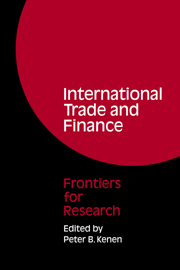Book contents
- Frontmatter
- Contents
- List of Contributors
- Preface
- PART I TRADE, PROTECTION, AND DOMESTIC PRODUCTION
- PART II ECONOMETRIC MODELS OF TRADE AND PAYMENTS
- Part III PAYMENTS ADJUSTMENT AND THE MONETARY SYSTEM
- Adjustment under Fixed and Flexible Exchange Rates
- International Reserves and Liquidity
- The LINK Model of World Trade, with Applications to 1972–73
- Discussion
- PART IV AN OVERVIEW AND AGENDA
- Glossary of Frequently Used Acronyms
- Author Index
The LINK Model of World Trade, with Applications to 1972–73
Published online by Cambridge University Press: 05 November 2011
- Frontmatter
- Contents
- List of Contributors
- Preface
- PART I TRADE, PROTECTION, AND DOMESTIC PRODUCTION
- PART II ECONOMETRIC MODELS OF TRADE AND PAYMENTS
- Part III PAYMENTS ADJUSTMENT AND THE MONETARY SYSTEM
- Adjustment under Fixed and Flexible Exchange Rates
- International Reserves and Liquidity
- The LINK Model of World Trade, with Applications to 1972–73
- Discussion
- PART IV AN OVERVIEW AND AGENDA
- Glossary of Frequently Used Acronyms
- Author Index
Summary
MOTIVATIONS AND PARTICIPATION
Given that there are large, on-going econometric-model studies in many of the main industrial countries, how can these be linked together in a consistent way to analyze world trade flows and, more generally, the international transmission mechanism?
By and large, each national model is customarily simulated by itself or, at best, in a two-country model with a superficial treatment accorded to “the rest of the world.” It is possible to construct theoretical models with full cross-country interrelatedness, but the empirical implementation of such a system must necessarily give fairly sweeping and uniform treatment to each national component. The LINK approach is quite different. We try to use the full detail and intimate knowledge that each national model builder has imparted to his own system by taking what is already available and concentrating efforts on building the linkages among all the parts.
Some basic decisions were taken when the LINK project was begun in 1968:
a. Each national model will provide estimates of import equations, with exports being determined from international share relationships. Short of building a complete set of bilateral relationships, we had to decide whether to work primarily on the side of imports or exports in national models. We chose the former.
b. Imports of goods are to be valued f.o.b. and split into a fixed number of categories for each country:
SITC 0, 1 food, beverage, and tobacco
2, 4 basic materials
3 mineral fuels (mainly oil)
5–9 manufactures.
Services are treated in a separate category.
- Type
- Chapter
- Information
- International Trade and FinanceFrontiers for Research, pp. 453 - 484Publisher: Cambridge University PressPrint publication year: 1976



